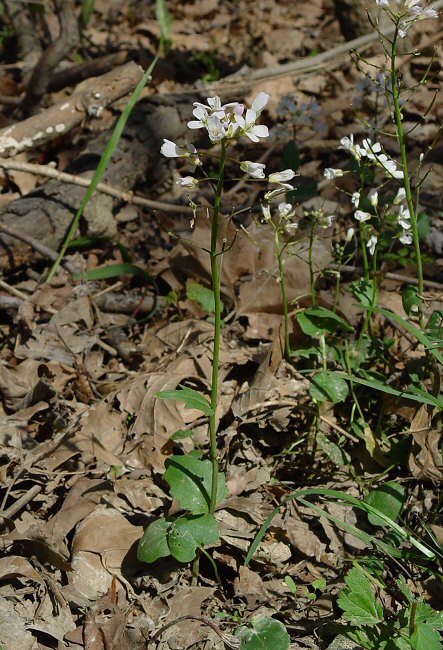Cardamine douglassii Britton
Purple Cress

Native
CC = 9
CW = -3
MOC = 12
© DETenaglia
Cardamine douglassii BrittonPurple Cress | |
 |
Native CC = 9 CW = -3 MOC = 12 |
© DETenaglia |
|
Family - Brassicaceae Habit - Perennial forb with short, tuberous, unsegmented rhizomes. Stems - Ascending to erect, to 30 cm, terete, simple or sparsely branched in the apical half, with spreading hairs 0.3-0.6 mm long, especially in the apical half.
Leaves - Alternate, petiolate below, becoming sessile above, 2-7 cm long, simple, entire, wavy-margined, or with few, shallow, widely spaced teeth, often sparsely hairy; the basal leaves usually withered by flowering time, long-petiolate, the leaf blades ovate to cordate; the stem leaves mostly 3-5, mostly sessile, ovate to lanceolate or narrowly elliptic.
Inflorescence - Terminal raceme, compact in flower, quickly elongating in fruit up to 15 cm. Axis mostly glabrous. Pedicels ascending, to 2.5 cm in fruit, glabrous.
Flowers - Sepals 4, 3.0-6.0 mm long, reddish purple. Petals 4, 8-14 mm long, pink to purplish pink. Styles 3-4 mm long.
Fruits - Siliques 25-40 mm long, sometimes aborting before maturity, 2-valved, with a beak to 4mm long, slightly constricted between the seeds. Seeds 1.7-2.1 mm long, irregularly oblong to circular in outline, the surface slightly roughened, orange to greenish yellow.
Flowering - March - April. Habitat - Mesic or bottomland forests. Origin - Native to the U.S. Lookalikes - C. bulbosa. Other info. - This attractive species can be found mainly in a handful of counties in the northeastern corner of Missouri. The plant can be identified by its reniform basal leaf blades, sessile cauline leaves, and big flowers. The flowers are typically pink to purple but the plants photographed in Columbia, MO., had white flowers. The upper stems usually bear short, spreading hairs which further serve to differentiate this species from the closely related C. bulbosa. Photographs taken off the MKT Trail, Columbia, MO., 4-15-04 (DETenaglia). |